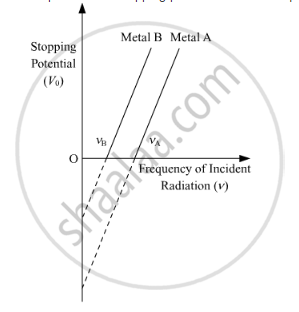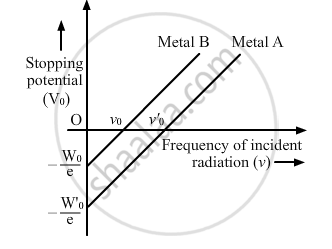Advertisements
Advertisements
प्रश्न
Sketch the graphs showing variation of stopping potential with frequency of incident radiations for two photosensitive materials A and B having threshold frequencies vA > vB.
(i) In which case is the stopping potential more and why?
(ii) Does the slope of the graph depend on the nature of the material used? Explain.
उत्तर
(i)
Graph between stopping potential and the frequency of the incident radiation:

From the graph, we note:
(i) The stopping potential is inversely proportional to the threshold frequency. Hence the stopping potential is higher for metal B.
(ii) The slope of the graph does not depend on the nature of the material used.
As we know,
Kmax= hv − ϕ0 = eV0
Dividing the whole equation by e , we get
`(hv)/e-phi_0/e=V_0`
From the above equation, the slope of the graph is `h/e`(on comparing with the straight line equation). Thus, we see that the slope is independent of the nature of the photoelectric material.
APPEARS IN
संबंधित प्रश्न
Light of intensity ‘I’ and frequency ‘v’ is incident on a photosensitive surface and causes photoelectric emission. What will be the effect on anode current when (i) the intensity of light is gradually increased. In each case, all other factors remain the same. Explain, giving justification in each case.
Two monochromatic beams, one red and the other blue, have the same intensity. In which case (i) the number of photons per unit area per second is larger, (ii) the maximum kinetic energy of the photoelectrons is more? Justify your answer.
Draw a plot showing the variation of photoelectric current versus the intensity of incident radiation on a given photosensitive surface.
The graph shows the variation of stopping potential with frequency of incident radiation for two photosensitive metals A and B. Which one of the two has higher value of work-function? Justify your answer.

The work functions for potassium and caesium are 2.25 eV and 2.14 eV respectively. Is the photoelectric effect possible for either of them if the incident wavelength is 5180 Å?
[Given : Planck’s constant = 6.63 x 10–34 J.s.;
Velocity of light = 3 x 108 m/s; 1 eV = 1.6 x 10–19 J]
A photosensitive surface emits photoelectrons when red light falls on it. Will the surface emit photoelectrons when blue light is incident on it? Give reason.
Use Einstein's photoelectric equation to explain the observations from this graph ?
Calculate the momentum of a photon of energy 6 x I 0-19 J.
Two metals A and B have work functions 4 eV and 6 eV respectively. Which metal has a lower threshold wavelength for photoelectric effect?
If the frequency of the incident radiation is increased from 4 × 1015 Hz to 8 × 1015 Hz, by how much will the stopping potential for a given photosensitive surface go up?
